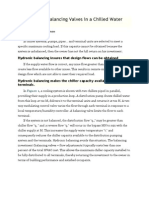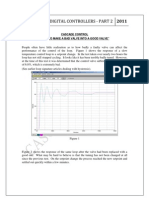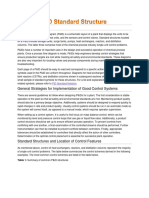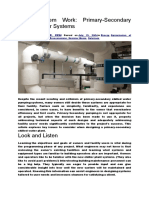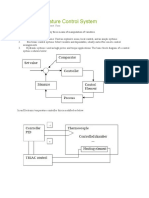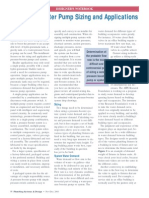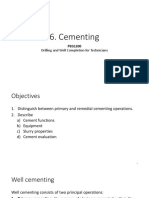Hydronic Balancing - A Necessity For Good Control
Hydronic Balancing - A Necessity For Good Control
Uploaded by
Antonio LebrunCopyright:
Available Formats
Hydronic Balancing - A Necessity For Good Control
Hydronic Balancing - A Necessity For Good Control
Uploaded by
Antonio LebrunOriginal Description:
Original Title
Copyright
Available Formats
Share this document
Did you find this document useful?
Is this content inappropriate?
Copyright:
Available Formats
Hydronic Balancing - A Necessity For Good Control
Hydronic Balancing - A Necessity For Good Control
Uploaded by
Antonio LebrunCopyright:
Available Formats
Hydronic balancing 1
Hydronic balancing - a necessity for good control
Introduction
In theory, modern HVAC systems can satisfy the most demanding requirements for indoor climate and
operating costs. In practice, however, not even the most sophisticated controllers always perform as
promised. As a result, comfort is compromised and operational costs are higher than expected.
This is often because the mechanical design of the HVAC plant does not meet some conditions necessary
for stable and accurate control. Three important conditions are:
1. The design flow must be available at all terminals.
2. The differential pressures across the control valves must not vary too much.
3. Flows must be compatible at system interfaces.
This article discusses in brief the first of these conditions - problems resulting from violation of condition 1,
why the problems occur and how to prevent them at the design stage.
Common problems
These problems are typical indications that condition number one (i.e. that the design flow is not available
at each terminal) is not met:
- Higher than expected energy costs.
- Installed power is not deliverable at intermediate and/or high load.
- Too hot in some parts of the building, too cold in other parts.
- Long delay before the desired room temperatures are obtained when starting up after night setback.
Obtaining the correct flows
The power transmitted by a terminal unit depends on the supply water temperature and the water flow.
These parameters are controlled to obtain the required room temperatures. Control is only possible if the
required water flows are available.
Some people, however, seem to think that it is sufficient to indicate design flows on the drawings in order
to obtain them in the pipes. But to obtain the required flows, they must be measured and adjusted. This is
why specialists are convinced that hydronic balancing is essential. The discussion is limited to the question:
how to do it? Is it, for instance, possible to obtain a correct flow distribution by sizing the plant carefully?
The answer, in theory, is yes. But in practice it's just a dream.
Production units, pipes, pumps and terminals are designed to cover the maximum needs (unless the plant
is calculated with a diversity factor). If a link of the chain is not properly sized, the others will not perform
optimally. As a result, the desired indoor climate will not be obtained and the comfort will be compromised.
One might think that designing the plant with some security factors would prevent most problems.
However, even if some problems are solved that way, others are created, particularly on the control side.
Some oversizing cannot be avoided, because components must be selected from existing commercial
ranges. These generally do not fit the calculations made. Moreover, at design stage, the characteristics of
some components are not known since they will be selected by the contractor at a later stage. It is then
necessary to make some corrections taking also into account the real installation which frequently differs
somewhat from the initial design.
Hydronic balancing enables the required flows to be obtained in the actual installation, compensates for
oversizing and justifies the investments made
Distribution systems with constant flow
In a distribution system with constant flow (Figure 1a), the three-way valve is calculated to create a
pressure drop at least equal to the design pressure drop in the coil _C". This means a control valve authority
of at least 0.5, which is essential for good control. If the pressure drop in the coil plus the pressure drop of
the control valve is 20 kPa and the available differential pressure H is 80 kPa, then the difference of 60
Hydronic balancing 1
kPa must be taken away by the balancing valve STAD1. If not, this circuit will experience an overflow of
200%, making control difficult and disturbing the rest of the plant.
In figure 1b, the balancing valve STAD2 is essential. Without it, the bypass AB will be a short circuit with
an extreme overflow, creating underflows elsewhere in the plant. With STAD2, the primary flow qp is
measured and adjusted to be a somewhat higher than the secondary design flow qs measured and adjusted
with STAD3. If qs > qp, the water flow reverses in the bypass AB, creating a mixing point on A. The
supply water temperature will increase in cooling and decrease in heating and the design power will not be
obtainable on the terminal units
A
H
qp
qp
qs
BPV
STAD-1
STAD-2
STAD-3
Fig 1. Examples of circuits in constant flow distribution systems.
Balancing ensures correct flow distribution, prevents operational problems and lets controllers really
control.
Distribution system with variable flow
In a distribution system with variable flow, underflow problems occur essentially at high loads.
Chiller1
Terminal unit
Charge
Chiller 2
80%
Fig 2. Example of a variable flow distribution system.
At first glance, there appears to be no reason to balance a system with two-way control valves on the
terminals, since the control valves are designed to modulate the flow to the required level. Hydronic
balancing should therefore be obtained automatically. However, even after careful calculations, you find
that control valves with exactly the required Kvs are not available on the market. Consequently, most
control valves are oversized. Total opening of the control valves cannot be avoided in many situations, such
as during start up, when big disturbances occur, when some thermostats are set at minimum or maximum
value or when some coils have been undersized. In these cases and when balancing valves are not in place,
overflows will result in some circuits. This will create underflow in other circuits.
Using a variable speed pump will not solve this problem since all the flows will change proportionally
when the pump head is modified. Attempting to avoid overflows this way will simply make the underflows
more significant.
The entire plant is designed to provide its maximum power at maximum load. It is then essential that this
maximum power is available when required. Hydronic balancing, made in design conditions, guarantees
that all terminals can receive their required flow, thus justifying the investments made. At partial loads,
when some control valves close, the available differential pressures on the circuits can only increase. If
underflows are avoided in design conditions, they will not occur in other conditions.
Hydronic balancing 1
Morning start up
In distribution systems with variable flows, morning start-up after each nigh time setback is a serious
consideration since most control valves are driven fully open. This creates overflows which produce
unpredictable pressure drops in some of the piping network, starving the terminals in the less favoured
sections of the system. The unfavoured circuit will not receive adequate flow until the favoured spaces have
reached thermostat set point (if these set points have been reasonably chosen), allowing their control valves
to begin to throttle. Start up is therefore difficult and takes a longer time than expected. This is costly in
terms of energy consumption. A non uniform start-up makes management by a central controller and any
form of optimisation practically impossible.
Room temperatures
Occupancy point
Favoured circuits
it
cu
cir
d
re
ou
fav
n
U
-4
Plant balanced
-2
Time in hours
Extra start up time
Fig 3. An unbalanced plant has to start up earlier, increasing the energy consumption.
In a distribution system with constant flow, underflows and overflows remain both during and after start up,
making the problem much more difficult.
The tools required for balancing
To balance a plant, the required tools must meet these conditions:
The flow must be measurable with an accuracy of around 5%. The balancing procedure makes it
possible to check if the plant works as designed, to detect faults and to decide upon measures to correct
them.
The flow must be easy to adjust, thus making the plant flexible.
The balancing device must guarantee a long term reliability. It must be resistant to aggressive water.
During flushing, the balancing devices should not have to be removed and should not require the use of
special filters.
The setting position must be easy to read and be protected by a hidden memory. Full throttling range
should require at least four full turns of the handwheel to enable sufficient resolution of the setting.
A balanced cone should be available for big sizes to reduce the torque required to set the valve against
high differential pressures.
A shut-off function must be included in the balancing valve.
A measuring instrument must be available, so that flows can be measured easily, without having to use
diagrams. The instrument should incorporate a simple balancing procedure and the possibility to print a
balancing report. The instrument also enable the evolution of flows, differential pressures and
temperatures to be registered for diagnostic purposes.
Balancing made simple
Hydronic balancing provides the opportunity to verify that the installation is correctly executed. It enables
detection and subsequent correction of most malfunctions ( air, clogging, filters, hydronic faults...).
Using the TA Balance method is the easiest way to balance a plant. TA Balance is a computer
programme based on the compensated method. TA Balance is incorporated into the balancing instrument
CBI. After some measurements in the plant, TA Balance calculates the correct settings for the balancing
valves. The main advantage of this method is that one man, working alone, can balance an entire plant using
only one balancing instrument.
Hydronic balancing 1
As in all other balancing procedures, the plant must be divided in modules.
One module is formed by several circuits connected to the same supply and return pipes. Each circuit has
its own balancing valve. Each module has a common balancing valve called the partner valve ( Fig 4).
module
Partner valve
Fig 4. Balancing module.
The CBI detects the index circuit (the circuit that requires the highest differential pressure) and allocates a
pressure drop of 3 kPa for the balancing valve of this circuit ( the minimum pressure drop required for
reliable flow measurements). The settings of the other balancing valves are determined to obtain a relative
balancing of the elements within the module. The settings do not depend on the actual available pump head
or on the setting of other balancing valves in the plant. The determined values are set and locked.
When all modules have been individually balanced, the modules are then balanced in relation to one
another using the same procedure. At this stage, the settings of the partner valves are determined.
Finally, the total design flow is adjusted with the main balancing valve. All overpressure is taken and
measured in this valve. This overpressure is sometimes so high that a smaller pump can be installed to
reduce pumping costs.
When this operation is completed, design flows are available at all terminals. A computer printout
provides a list of settings, differential pressures and water flows for each balancing valve.
Conclusion
The objective of any HVAC plant is to provide a comfortable indoor climate while minimising costs and
operating problems.
In theory, modern control technology makes this objective obtainable. In practice however, not even the
most sophisticated controllers always perform as promised. The reason is often that the conditions
necessary for their proper operation are not fulfilled.
The whole plant is designed for maximum load. If full load cannot be obtained because some terminals
are in underflow, the comfort is not reached and the investment costs not valorised.
Hydronic balancing prevents overflow in some circuits from causing underflow in others and detects the
degree of pump oversizing. It verifies that the plant works as designed, allowing to reach a comfortable
environment at lower costs.
Reference:
R. Petitjean, Total hydronic balancing. Second edition.
Edition Tour & Andersson Hydronics - 530 pages - 1997
You might also like
- HVAC Controls Answers CHP 1-5Document11 pagesHVAC Controls Answers CHP 1-5Cheuk To ChanNo ratings yet
- Module 05 Centrifugal Compressors Trouble ShootingDocument18 pagesModule 05 Centrifugal Compressors Trouble Shootingsivagulf100% (1)
- Masoneilan Control Valve SizingDocument13 pagesMasoneilan Control Valve SizingZakariya100% (1)
- Hot Water Circulation - Designers Guide PDFDocument3 pagesHot Water Circulation - Designers Guide PDFAntonio Lebrun100% (1)
- Honeywell Damper Selection and SizingDocument20 pagesHoneywell Damper Selection and SizingroadiewebNo ratings yet
- Lighting Circuits PDFDocument59 pagesLighting Circuits PDFjroselNo ratings yet
- The Need For Balancing Valves in A Chilled Water SystemDocument50 pagesThe Need For Balancing Valves in A Chilled Water SystemNoushad P Hamsa100% (1)
- Need For Balancing ValvesDocument12 pagesNeed For Balancing ValvesBubai111No ratings yet
- FlowCon PICV Write OutDocument17 pagesFlowCon PICV Write OutmajortayNo ratings yet
- Handbook No 1 Balancing of Control LoopsDocument56 pagesHandbook No 1 Balancing of Control Loopstomislav_vucinic100% (1)
- DecouplerDocument9 pagesDecouplerMostafa KamelNo ratings yet
- A Second Look at ElectroDocument7 pagesA Second Look at ElectroPHÁT NGUYỄN THẾNo ratings yet
- Distillation ColumnDocument9 pagesDistillation ColumnhichamNo ratings yet
- SL 0011 System Bypass Design Considerations 5.21.14Document4 pagesSL 0011 System Bypass Design Considerations 5.21.14MamunNo ratings yet
- Cascade LoopDocument6 pagesCascade LoopAhmed EldosokyNo ratings yet
- Advantages of Pressure Independent Control ValvesDocument3 pagesAdvantages of Pressure Independent Control ValvesMohamed Aboobucker Mohamed IrfanNo ratings yet
- SYS-APM001-En Chiller System Design and ControlDocument2 pagesSYS-APM001-En Chiller System Design and ControlAtiqNo ratings yet
- Hydronic BalanceDocument46 pagesHydronic BalanceRamadan RashadNo ratings yet
- Expansion Tank PDFDocument9 pagesExpansion Tank PDFKrishna Chaitanya Kalaga100% (1)
- Graph Installed Flow and Gain PI Mag 03 21Document11 pagesGraph Installed Flow and Gain PI Mag 03 21FabioSalaNo ratings yet
- Operation of The System: How ToDocument6 pagesOperation of The System: How ToIren HofilenaNo ratings yet
- Common Sense Approaches To Control Valve Sizing Jeff Peshoff AWC, IncDocument6 pagesCommon Sense Approaches To Control Valve Sizing Jeff Peshoff AWC, IncJOSE MARTIN MORA RIVEROS100% (1)
- The Contribution of Valves in Maximum Power Plant PerformanceDocument6 pagesThe Contribution of Valves in Maximum Power Plant PerformanceUdhayakumar Venkataraman100% (1)
- PID Standard StructureDocument15 pagesPID Standard StructureNghiep TranNo ratings yet
- Pumping System Parameters To Consider For Your Medical Instrument-KNF - PumpingSystemDocument4 pagesPumping System Parameters To Consider For Your Medical Instrument-KNF - PumpingSystemRobby RenzNo ratings yet
- Making Them Work: Primary-Secondary Chilled Water SystemsDocument9 pagesMaking Them Work: Primary-Secondary Chilled Water Systemspsn_kylmNo ratings yet
- Constant Vs Variable FlowDocument2 pagesConstant Vs Variable FlowbatazivoNo ratings yet
- Process Engineering - Understand and Control Hot Vapor Bypass - Chemical ProcessingDocument6 pagesProcess Engineering - Understand and Control Hot Vapor Bypass - Chemical Processingmurugan1984No ratings yet
- Installation and Commissioning of Controls: Block 5 Basic Control TheoryDocument10 pagesInstallation and Commissioning of Controls: Block 5 Basic Control TheoryPablo Leon RoblesNo ratings yet
- 02 Control ValvesDocument10 pages02 Control ValvesPoint LogNo ratings yet
- Fundamentals of Cascade ControlDocument6 pagesFundamentals of Cascade ControlCyrix.One100% (1)
- Common Hydraulic System ProblemsDocument3 pagesCommon Hydraulic System ProblemsVINOD Y BNo ratings yet
- Control Valve SizingDocument7 pagesControl Valve SizingJojolas100% (1)
- Rest Room: Chiller Staging ProblemsDocument9 pagesRest Room: Chiller Staging ProblemsstranfirNo ratings yet
- Econ Double Regulating ValvesDocument18 pagesEcon Double Regulating ValvesEngr.MmosaadNo ratings yet
- VFCCP102cooling SystemDocument8 pagesVFCCP102cooling SystemblindjaxxNo ratings yet
- Primary & Secondary LoopsDocument33 pagesPrimary & Secondary LoopsQOBITNo ratings yet
- The Do's & Don'Ts of Hydronic System DesignDocument6 pagesThe Do's & Don'Ts of Hydronic System DesignNiong DavidNo ratings yet
- Basic Temperature Control SystemDocument26 pagesBasic Temperature Control SystemRajeev Valunjkar100% (1)
- Krohne WPX 1017 NewDocument7 pagesKrohne WPX 1017 NewHazopsilNo ratings yet
- Auto1 Kupe5 Co1 Week 5 6 ResurreccionDocument40 pagesAuto1 Kupe5 Co1 Week 5 6 ResurreccionRency ResurreccionNo ratings yet
- Process Control Elements in The LoopDocument13 pagesProcess Control Elements in The LoopTimothy LeonardNo ratings yet
- Pressure Boosting PumpsDocument4 pagesPressure Boosting PumpsmabuhayehNo ratings yet
- Closed Loop Chilled Water Makeup Water - Expansion Tank - Air Separator - HVAC - R Engineering - Eng-TipsDocument4 pagesClosed Loop Chilled Water Makeup Water - Expansion Tank - Air Separator - HVAC - R Engineering - Eng-TipsMoiz TinwalaNo ratings yet
- Econ Double Regulating ValvesDocument18 pagesEcon Double Regulating ValvesElimKaAdda100% (1)
- Water Filters Residential 5600SXT Activated Carbon Filters ENGLISH Canadian ManualDocument12 pagesWater Filters Residential 5600SXT Activated Carbon Filters ENGLISH Canadian ManualPromagEnviro.comNo ratings yet
- Why Bladder Tanks - 8!16!17Document10 pagesWhy Bladder Tanks - 8!16!17bla blaNo ratings yet
- Double Regulating Valves (2601V)Document7 pagesDouble Regulating Valves (2601V)Sujit RajanNo ratings yet
- I3 Steam Systems 16 20Document5 pagesI3 Steam Systems 16 20qayoom5629No ratings yet
- Constant Volume - Constant Speed. Chilled Water Systems. Chillers Pumps & PiDocument3 pagesConstant Volume - Constant Speed. Chilled Water Systems. Chillers Pumps & PiMohamed AdelNo ratings yet
- 23 09 13.33 - Control ValvesDocument25 pages23 09 13.33 - Control Valvesforevertay2000No ratings yet
- PLC Based Boiler PressureDocument3 pagesPLC Based Boiler PressureNeel Das Gupta MNo ratings yet
- 1048E - Delta P Valves - System Design ManualDocument29 pages1048E - Delta P Valves - System Design Manualrama_easNo ratings yet
- Working Principle of Control Valve With DiagramDocument10 pagesWorking Principle of Control Valve With DiagramKhamis AfendiNo ratings yet
- HTTP WWW - Spiraxsarco.com Resources Steam-Engineering-tutorials Control-Applications Pressure-Contr NewDocument15 pagesHTTP WWW - Spiraxsarco.com Resources Steam-Engineering-tutorials Control-Applications Pressure-Contr NewPalash KayathwalNo ratings yet
- Strategy For DistillationColumn ControlDocument529 pagesStrategy For DistillationColumn ControlLisandro Mangini100% (2)
- Pressure Booster SizingDocument4 pagesPressure Booster SizingSam Choi100% (1)
- WP 010 Delta ElectrohydrailicsDocument6 pagesWP 010 Delta ElectrohydrailicsJigar M. UpadhyayNo ratings yet
- Anti Surge ControllersDocument6 pagesAnti Surge Controllersalimohebbi1361100% (1)
- Final - PID PaperDocument17 pagesFinal - PID PaperAhmed KhairiNo ratings yet
- Diagnosis and Robust Control of Complex Building Central Chilling Systems for Enhanced Energy PerformanceFrom EverandDiagnosis and Robust Control of Complex Building Central Chilling Systems for Enhanced Energy PerformanceNo ratings yet
- HVAC Design For Corrosive EnvironmentDocument29 pagesHVAC Design For Corrosive Environmentطاہر رضاNo ratings yet
- Specification Analog ControlDocument1 pageSpecification Analog ControlAntonio LebrunNo ratings yet
- Debullet - ASHRAE - BASIC CHILLER PLANT DESIGN PDFDocument59 pagesDebullet - ASHRAE - BASIC CHILLER PLANT DESIGN PDFraviNo ratings yet
- The Benefits of Utilizing Series Counterflow Variable Speed Screw ChillersDocument11 pagesThe Benefits of Utilizing Series Counterflow Variable Speed Screw ChillersAntonio LebrunNo ratings yet
- ASHRAE - The Fundamentals of Expansion Tanks PDFDocument7 pagesASHRAE - The Fundamentals of Expansion Tanks PDFAntonio LebrunNo ratings yet
- ASHRAE - The Fundamentals of Expansion Tanks PDFDocument7 pagesASHRAE - The Fundamentals of Expansion Tanks PDFAntonio LebrunNo ratings yet
- ASHRAE - Series Series Counterflow For Central Chilled Water PlantsDocument7 pagesASHRAE - Series Series Counterflow For Central Chilled Water PlantsAntonio LebrunNo ratings yet
- Back To Basics - Duct DesignDocument17 pagesBack To Basics - Duct DesignAntonio LebrunNo ratings yet
- Strada Ep: Redefining The Reliability, Durability, and Control of The Espresso MachineDocument2 pagesStrada Ep: Redefining The Reliability, Durability, and Control of The Espresso MachineMangga88dNo ratings yet
- Design of Tubular MembersDocument39 pagesDesign of Tubular MembersSaikrishna Gazula100% (1)
- Solar Powered Water Systems Design and Installation Guide - Water Mission - UNICEFDocument123 pagesSolar Powered Water Systems Design and Installation Guide - Water Mission - UNICEFThierno Sow100% (1)
- DFT Studies On Half Heusler CompoundsDocument29 pagesDFT Studies On Half Heusler CompoundsTathagata SarkarNo ratings yet
- Candy Dryer ManualDocument24 pagesCandy Dryer ManualAlex GasicNo ratings yet
- Thermodynamics in BiochemistryDocument16 pagesThermodynamics in BiochemistrySurya DoleyNo ratings yet
- The Reflection Coefficient TransformationDocument7 pagesThe Reflection Coefficient Transformationhms90No ratings yet
- English Mock-1Document17 pagesEnglish Mock-1shubhamgavali83No ratings yet
- On Hand19.10.2022Document466 pagesOn Hand19.10.2022melakuNo ratings yet
- Pulso Oximetro 1905 RiesterDocument2 pagesPulso Oximetro 1905 RiestereduardoNo ratings yet
- DrawingsDocument29 pagesDrawingsTarun BiswalNo ratings yet
- Trucon AssociatesDocument16 pagesTrucon AssociatessanchaNo ratings yet
- MWM Factsheet 2011 enDocument2 pagesMWM Factsheet 2011 enAbhijit MannaNo ratings yet
- Final Year PapDocument8 pagesFinal Year PapSanioSunojNo ratings yet
- Lecture - 5 SemtDocument12 pagesLecture - 5 SemtchetanNo ratings yet
- CementingDocument43 pagesCementingMax SinghNo ratings yet
- 2019 Advance Alliance Autograph Owners ManualDocument178 pages2019 Advance Alliance Autograph Owners ManualJose Luis DelgadoNo ratings yet
- Turbo Pump Turbo Pump: Exploded ViewDocument1 pageTurbo Pump Turbo Pump: Exploded ViewCarl Neil DomingoNo ratings yet
- Fujitsu Utbgca Kumanda Servis ManualDocument82 pagesFujitsu Utbgca Kumanda Servis ManualCan KATINo ratings yet
- EATON Circuit BreakersDocument1 pageEATON Circuit BreakersV ProcNo ratings yet
- Finite Element Method: 3.0 Fe Theory: General ContinuumDocument30 pagesFinite Element Method: 3.0 Fe Theory: General ContinuumEmre UysalNo ratings yet
- Transmission SystemDocument13 pagesTransmission SystemSYEDMUSTAFA QAZINo ratings yet
- ControlDocument59 pagesControlTuan Anh Nguyen HuuNo ratings yet
- Mounting StructureDocument41 pagesMounting StructureAcharan Chandel100% (1)
- Separations and Reaction Engineering Design Project Production of AmmoniaDocument10 pagesSeparations and Reaction Engineering Design Project Production of AmmoniaRyan WahyudiNo ratings yet
- Part 01 Joint Business Practice Request For TenderDocument73 pagesPart 01 Joint Business Practice Request For Tenderfabiano_projetoNo ratings yet
- 4.0 AdsorptionDocument68 pages4.0 AdsorptionWazif ZakwanNo ratings yet
- VIP 1 Thermodynamics ExamDocument10 pagesVIP 1 Thermodynamics ExamJaybee LabraNo ratings yet
- 2013 Web Pillar Higwall Mining Extraction PDFDocument11 pages2013 Web Pillar Higwall Mining Extraction PDFtrinitrocainaNo ratings yet






